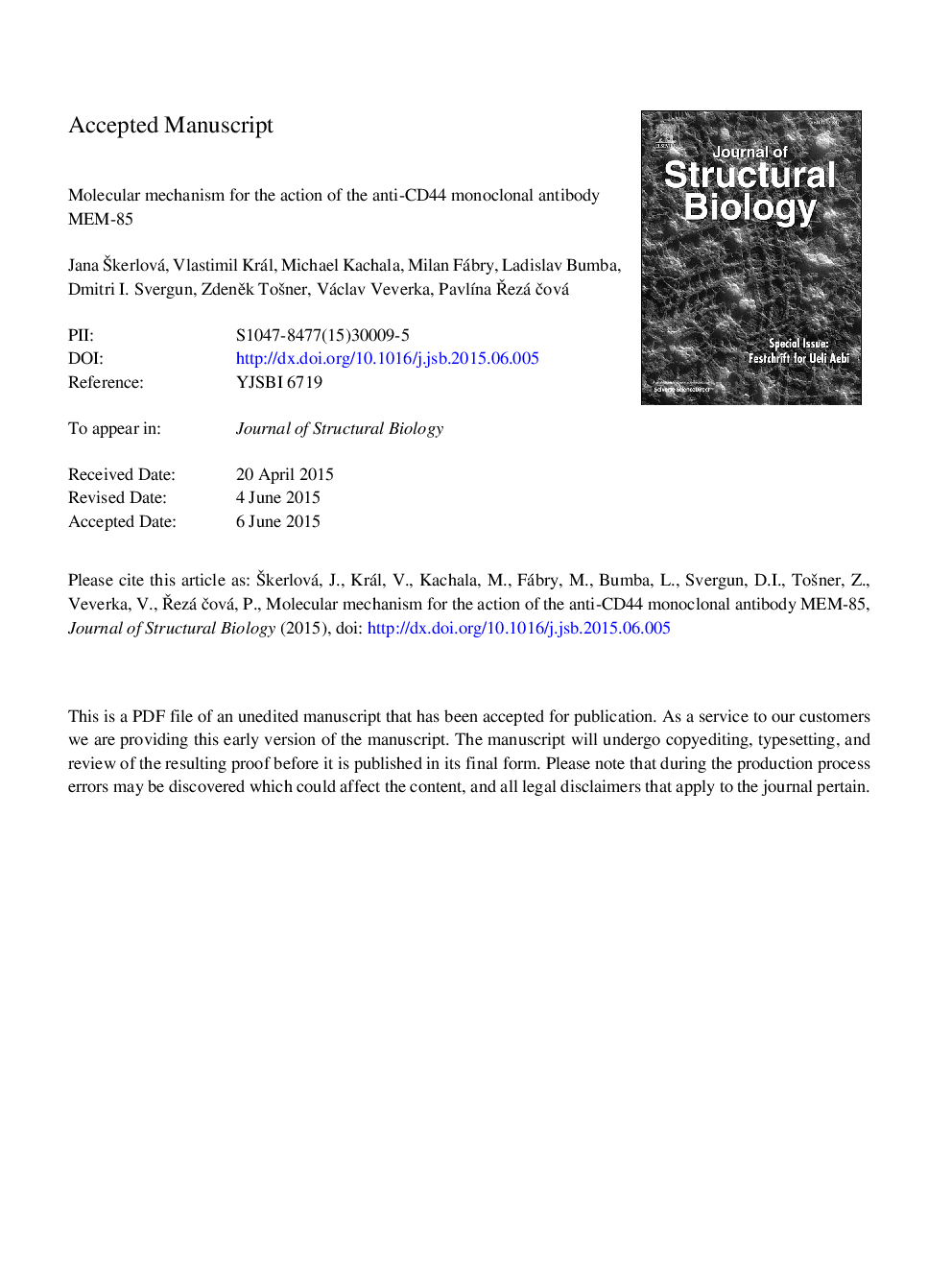| کد مقاله | کد نشریه | سال انتشار | مقاله انگلیسی | نسخه تمام متن |
|---|---|---|---|---|
| 5913763 | 1162701 | 2015 | 34 صفحه PDF | دانلود رایگان |
عنوان انگلیسی مقاله ISI
Molecular mechanism for the action of the anti-CD44 monoclonal antibody MEM-85
دانلود مقاله + سفارش ترجمه
دانلود مقاله ISI انگلیسی
رایگان برای ایرانیان
کلمات کلیدی
IPTGGAMCD44HSQCDmaxPDBscFvp(r)CDRFBSSAXSPBSMonoclonal antibody - آنتی بادی مونوکلونالisopropyl β-D-1-thiogalactopyranoside - ایزوپروپیل β-D-1-thiogalactopyranosideScattering vector - بردار پراکندهTev - به توNMR - تشدید مغناطیسی هستهای Surface plasmon resonance - تشدید پلاسمون سطحیSPR - تشدید پلاسمون سطحیMolecular mass - توده مولکولیfetal bovine serum - سرم جنین گاوRadius of gyration - شعاع نفوذgoat anti-mouse - ضد موش بزPhosphate buffered saline - فسفات بافر شورsingle-chain variable fragment - قطعه متغیر تک زنجیره ایOrdered - مرتب شدهcomplementarity determining region - منطقه تعریف مکملEpitope mapping - نقشه برداری اپیتوپwild type - نوع وحشیTobacco etch virus - ویروس تنباکو اچSmall-angle X-ray scattering - پراکندگی اشعه ایکس با زاویه کوچکForward scattering - پراکندگی به جلوProtein Data Bank - پروتئین بانک اطلاعاتیheteronuclear single quantum coherence - یکپارچگی کوانتومی تک هسته ای
موضوعات مرتبط
علوم زیستی و بیوفناوری
بیوشیمی، ژنتیک و زیست شناسی مولکولی
زیست شناسی مولکولی
پیش نمایش صفحه اول مقاله

چکیده انگلیسی
The hyaluronate receptor CD44 plays role in cell adhesion and migration and is involved in tumor metastasis. The extracellular domain of CD44 comprises the hyaluronate-binding domain (HABD) and the membrane-proximal stem region; the short intracellular portion interacts with adaptor proteins and triggers signaling pathways. Binding of hyaluronate to CD44 HABD induces an allosteric conformational change, which results in CD44 shedding. A poorly characterized epitope in human CD44 HABD is recognized by the murine monoclonal antibody MEM-85, which cross-blocks hyaluronate binding to CD44 and also induces CD44 shedding. MEM-85 is of therapeutic interest, as it inhibits growth of lung cancer cells in murine models. In this work, we employed a combination of biophysical methods to determine the MEM-85 binding epitope in CD44 HABD and to provide detailed insight into the mechanism of MEM-85 action. In particular, we constructed a single-chain variable fragment (scFv) of MEM-85 as a tool for detailed characterization of the CD44 HABD-antibody complex and identified residues within CD44 HABD involved in the interaction with scFv MEM-85 by NMR spectroscopy and mutational analysis. In addition, we built a rigid body model of the CD44 HABD-scFv MEM-85 complex using a low-resolution structure obtained by small-angle X-ray scattering. The MEM-85 epitope is situated in the C-terminal part of CD44 HABD, rather than the hyaluronate-binding groove, and the binding of MEM-85 induces a structural reorganization similar to that induced by hyaluronate. Therefore, the mechanism of MEM-85 cross-blocking of hyaluronate binding is likely of an allosteric, relay-like nature.
ناشر
Database: Elsevier - ScienceDirect (ساینس دایرکت)
Journal: Journal of Structural Biology - Volume 191, Issue 2, August 2015, Pages 214-223
Journal: Journal of Structural Biology - Volume 191, Issue 2, August 2015, Pages 214-223
نویسندگان
Jana Å kerlová, Vlastimil Král, Michael Kachala, Milan Fábry, Ladislav Bumba, Dmitri I. Svergun, ZdenÄk ToÅ¡ner, Václav Veverka, PavlÃna ÅezáÄová,